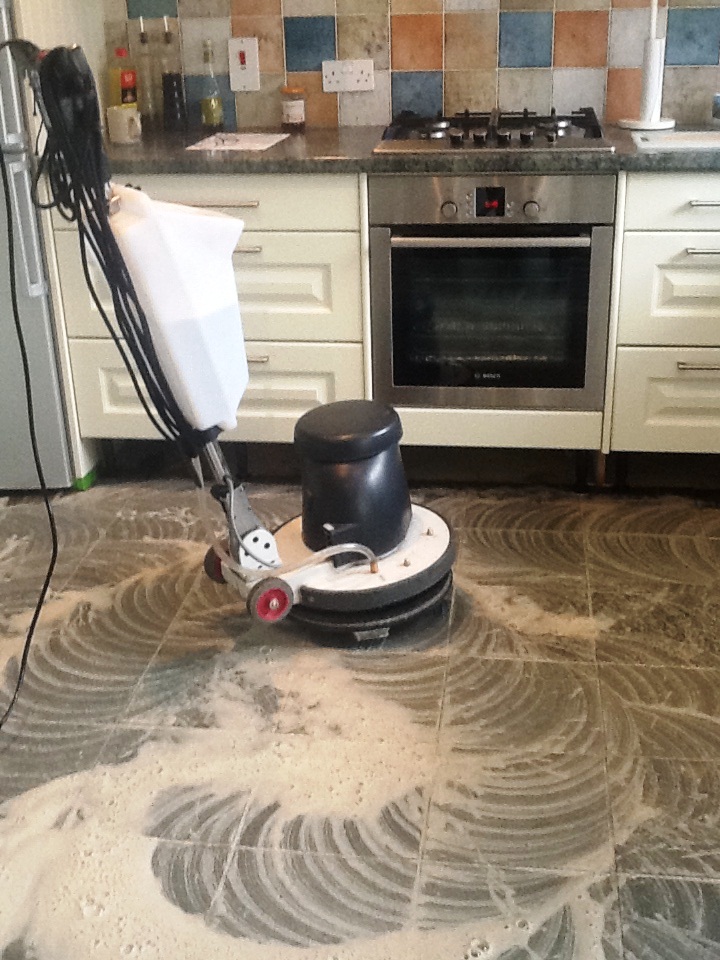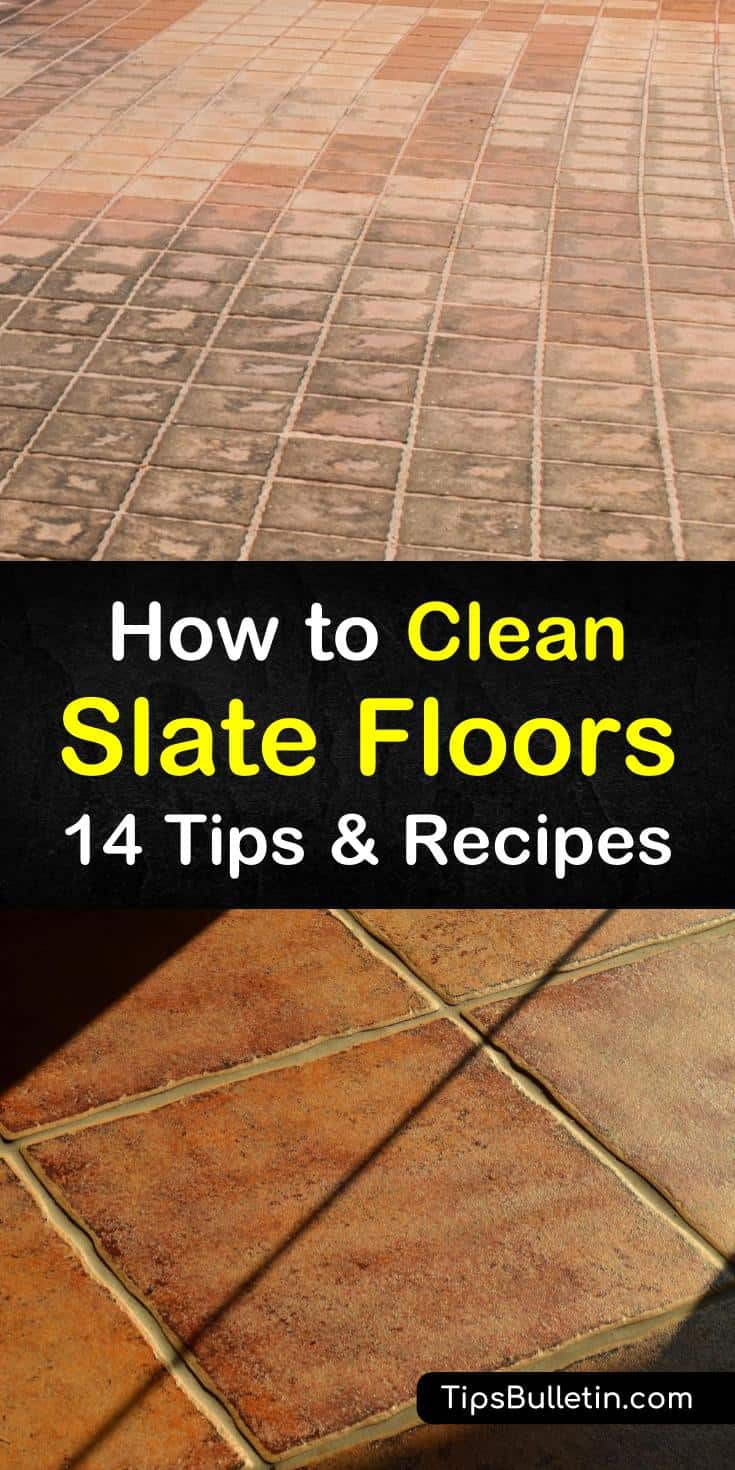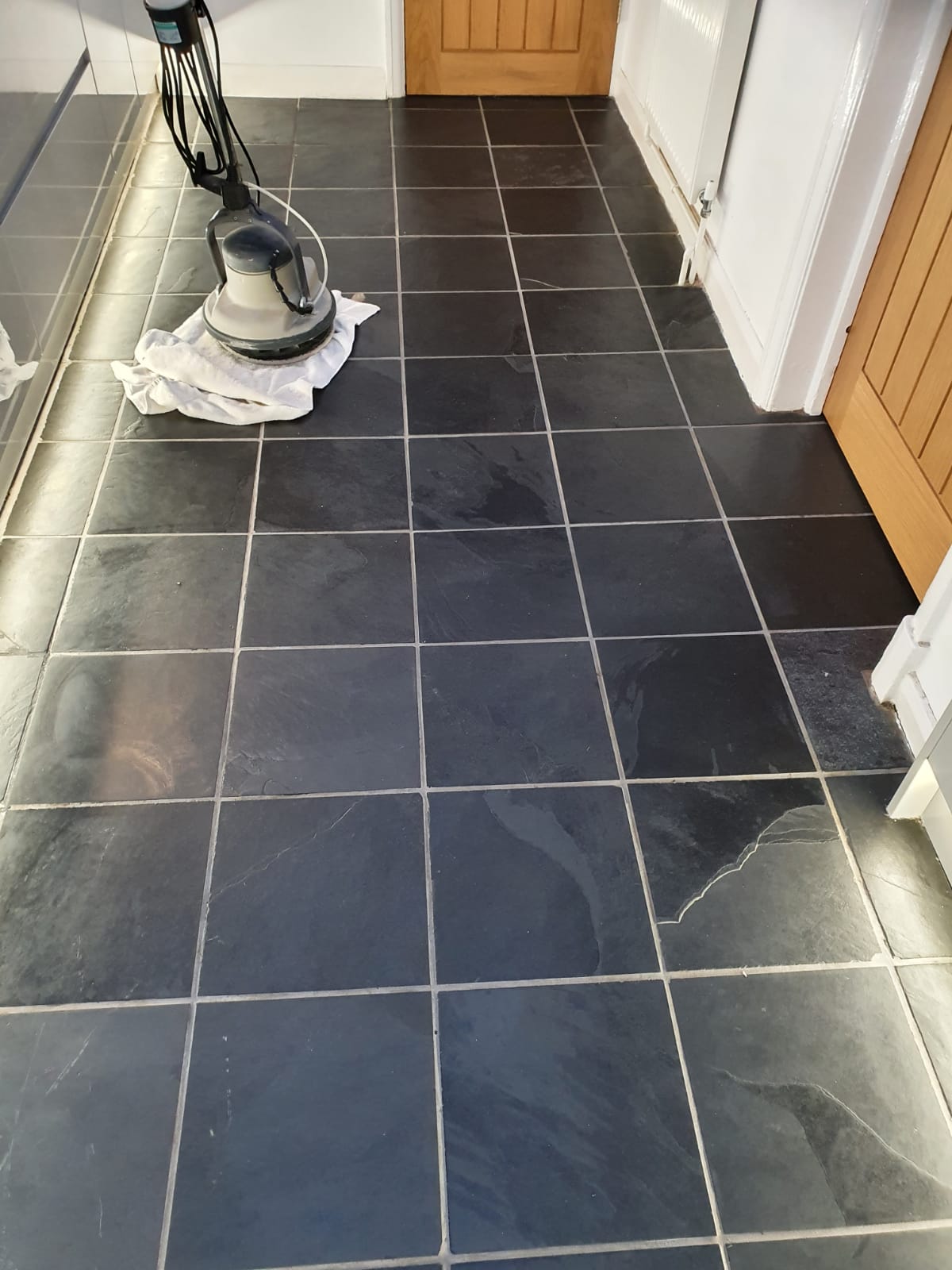Slate tile floors add a touch of natural elegance to any space, boasting durability and a unique, rustic aesthetic. However, maintaining their beauty requires proper care and cleaning techniques. Let me walk you through the essential steps and considerations for keeping your slate tile floors looking pristine.
Understanding Slate Tile Floors
Slate is a natural stone that is formed from clay, volcanic ash, and other materials over millions of years. This formation process gives slate its unique texture and appearance, which can vary widely in color and pattern. The natural variation in slate tiles means no two tiles are exactly alike, adding to its charm.
However, the unique composition of slate also means it is porous and can absorb liquids, which may lead to staining. It’s crucial to understand that slate requires regular maintenance and care to preserve its natural beauty. Sealing the tiles is an essential step in preventing damage and prolonging the life of your slate floors.
The hardness and durability of slate make it an excellent choice for high-traffic areas. However, this same hardness can make the tiles feel cold underfoot, and their uneven surface can be challenging to clean if not properly maintained. Understanding these characteristics helps in choosing the right cleaning methods and products.
When installing slate tile floors, it’s important to use suitable grout and ensure proper installation techniques to avoid issues like cracking or shifting tiles. The quality of installation plays a significant role in the longevity and ease of maintenance of your slate floors.
Lastly, the aesthetic appeal of slate tiles makes them a popular choice for both indoor and outdoor spaces. Whether you have slate in your kitchen, bathroom, patio, or hallway, knowing how to care for it can keep it looking beautiful for years to come.

Daily and Weekly Maintenance
Daily maintenance of slate tile floors involves simple practices that prevent dirt and debris from accumulating. Sweeping or vacuuming the floor regularly is crucial. Use a soft-bristle broom or a vacuum cleaner with a hard floor setting to avoid scratching the surface of the tiles.
In addition to sweeping, using a dry mop can help pick up fine dust particles that sweeping might miss. Microfiber mops are particularly effective for this purpose. For homes with pets or children, daily dry mopping can be especially beneficial in keeping the floors clean.
Weekly maintenance should include a more thorough cleaning routine. Use a damp mop with a pH-neutral cleaner specifically designed for natural stone. Avoid using harsh chemicals or acidic cleaners, as they can damage the slate’s surface. Dilute the cleaner according to the manufacturer’s instructions to prevent any residue build-up.
After mopping, it’s important to rinse the floor with clean water to remove any remaining cleaning solution. This step ensures that no soapy residue is left behind, which can dull the appearance of the slate tiles over time. Use a damp mop with plain water and go over the floor once more.
Dry the floor thoroughly after mopping to prevent water spots and streaks. You can use a clean, dry mop or a soft towel to remove excess moisture. This step is particularly important in areas with hard water, as mineral deposits can leave unsightly marks on the slate.
Incorporating these daily and weekly maintenance routines into your cleaning schedule helps maintain the natural beauty of slate tiles. Regular care not only keeps the floor looking good but also extends the life of the tiles by preventing scratches, stains, and other damage.
Deep Cleaning and Stain Removal
Despite regular maintenance, there comes a time when your slate tile floors will need a deep cleaning. Deep cleaning involves more intensive methods to remove embedded dirt, grime, and stains that regular cleaning might not address. It’s advisable to deep clean your slate floors every few months or as needed.
Begin by thoroughly sweeping or vacuuming the floor to remove loose dirt and debris. This step is essential to avoid scratching the slate during the deep cleaning process. Once the surface is clear, you can move on to using a specialized slate cleaner or a homemade cleaning solution.
For a homemade cleaning solution, mix warm water with a small amount of gentle dish soap. Avoid using vinegar or lemon juice, as their acidity can harm the slate. Using a soft-bristle brush, scrub the tiles gently to lift dirt from the porous surface. Pay extra attention to grout lines, where dirt tends to accumulate.
Rinse the floor thoroughly with clean water to remove all traces of the cleaning solution. It’s crucial to ensure no soap residue remains, as it can attract dirt and leave a dull film on the slate. Use a wet-dry vacuum or a mop to extract the rinse water effectively.
For stubborn stains, consider using a poultice made from baking soda and water. Apply the paste to the stain, cover it with plastic wrap, and let it sit for 24 hours. The baking soda will draw out the stain. Afterward, remove the poultice, rinse the area with water, and dry it thoroughly.
Once the floor is clean, it’s a good idea to apply a sealant if the slate looks worn or if it hasn’t been sealed recently. Sealing the tiles helps protect against future stains and makes regular cleaning easier. Choose a sealant recommended for slate and follow the manufacturer’s instructions for the best results.
Sealing and Protecting Slate Tile Floors
Sealing slate tile floors is a critical step in protecting them from stains, moisture, and wear. Slate is a porous material, which means it can absorb liquids and become stained if not properly sealed. Applying a high-quality sealant creates a protective barrier that enhances the durability and appearance of the tiles.
Before sealing, ensure the floor is completely clean and dry. Any dirt or moisture trapped under the sealant can cause issues later on. Use a pH-neutral cleaner to clean the slate thoroughly and allow ample time for the tiles to dry before applying the sealant.
Choose a sealant that is specifically designed for natural stone, particularly slate. There are different types of sealants available, including penetrating sealers and topical sealers. Penetrating sealers soak into the stone and provide long-lasting protection without altering the surface’s appearance, while topical sealers create a protective layer on top of the tiles.
Applying the sealant is straightforward but requires attention to detail. Use a clean, soft cloth or a brush to apply the sealant evenly across the surface of the slate tiles. Work in small sections to ensure even coverage and avoid missing any spots. Follow the manufacturer’s instructions regarding the number of coats needed and drying times between applications.
After the final coat of sealant has dried, buff the floor with a clean, dry cloth to remove any excess sealant and enhance the shine of the tiles. This step helps in achieving a uniform finish and prevents any streaking or residue.
Regularly resealing your slate floors is essential to maintain their protective barrier. Depending on the level of traffic and wear, you may need to reseal every one to two years. Performing a water test can help determine if resealing is necessary; if water no longer beads on the surface, it’s time to reseal.
Dealing with Common Issues
Slate tile floors, like any other type of flooring, can encounter a variety of issues over time. Being aware of these potential problems and knowing how to address them can help you maintain the beauty and functionality of your slate tiles.
One common issue is scratching. Despite its durability, slate can still get scratched by sharp objects or heavy furniture. To minimize scratches, place felt pads under furniture legs and avoid dragging heavy objects across the floor. Regularly sweep the floor to remove dirt and debris that can cause abrasion.
Stains are another concern, especially since slate is a porous material. Promptly clean up spills to prevent staining. For existing stains, use a poultice or a stone-specific stain remover. Avoid using harsh chemicals or acidic cleaners that can damage the slate’s surface.
Efflorescence, a white powdery residue, can sometimes appear on slate tiles due to moisture seeping through the stone and carrying salts to the surface. This issue is more common in outdoor installations or areas with high humidity. To remove efflorescence, use a soft brush and a stone-safe cleaner. Ensuring proper sealing and addressing any underlying moisture problems can help prevent recurrence.
Slate tiles can also become dull over time due to the accumulation of soap residue or improper cleaning. If your slate floor looks lackluster, deep cleaning followed by proper rinsing and drying can help restore its shine. Regularly using a pH-neutral cleaner will also prevent dulling.
Lastly, grout lines can become dirty and discolored. Regularly cleaning grout with a soft brush and a gentle cleaner helps maintain its appearance. For stubborn grout stains, consider using a grout cleaner or a mixture of baking soda and water. Sealing grout lines along with the slate tiles can also help protect against stains and dirt.
Common Mistakes to Avoid
While cleaning and maintaining slate tile floors, it’s important to avoid certain common mistakes that can damage the tiles or reduce their lifespan. Here are some pitfalls to watch out for:
Using Harsh Cleaners: Acidic or alkaline cleaners can damage slate tiles by etching the surface or breaking down the sealant. Always use pH-neutral cleaners specifically designed for natural stone.
Skipping Sealing: Failing to seal slate tiles leaves them vulnerable to stains and moisture damage. Regular sealing is essential to protect the tiles and make cleaning easier.
Over-Wetting: Using excessive water when cleaning slate can lead to water spots and mineral deposits. Always use a damp, not soaking wet, mop, and dry the floor thoroughly afterward.
Neglecting Regular Maintenance: Infrequent cleaning can lead to the buildup of dirt and grime, which can be more challenging to remove. Stick to a regular cleaning schedule to keep your slate floors looking their best.
Ignoring Spills: Letting spills sit on slate tiles can cause stains. Promptly clean up any spills to prevent staining and potential damage.
Using Abrasive Tools: Avoid using steel wool, scouring pads, or stiff brushes on slate tiles, as they can scratch and damage the surface. Stick to soft-bristle brushes and non-abrasive cleaning tools.
How often should I seal my slate tile floors?
I recommend sealing your slate tile floors every one to two years, depending on the level of traffic and wear. Performing a water test can help determine if resealing is necessary. If water no longer beads on the surface, it’s time to reseal. Regular sealing helps protect against stains and moisture, extending the life of your slate tiles.
Can I use vinegar to clean slate floors?
No, you should avoid using vinegar or any acidic cleaner on slate floors. Acidic substances can etch the surface of the slate and damage the sealant. Instead, use a pH-neutral cleaner specifically designed for natural stone. This ensures that your slate tiles remain undamaged and continue to look their best.
How do I remove stains from slate tiles?
To remove stains from slate tiles, you can use a poultice made from baking soda and water. Apply the paste to the stain, cover it with plastic wrap, and let it sit for 24 hours. The baking soda will draw out the stain. Afterward, remove the poultice, rinse the area with water, and dry it thoroughly. For stubborn stains, a stone-specific stain remover may be necessary.
What should I do if my slate tiles become dull?
If your slate tiles become dull, deep cleaning followed by proper rinsing and drying can help restore their shine. Use a pH-neutral cleaner and avoid any products that leave a residue. Regularly cleaning with the right products will prevent dulling. If the tiles are still dull after cleaning, applying a fresh coat of sealant can enhance their appearance.
Can I use a steam mop on slate floors?
It’s generally not recommended to use a steam mop on slate floors. The high heat and moisture can damage the sealant and the slate itself. Stick to using a damp mop with a pH-neutral cleaner. This method is safer for the slate and helps maintain its integrity and appearance.
How do I deal with efflorescence on slate tiles?
Efflorescence, a white powdery residue, can be removed by using a soft brush and a stone-safe cleaner. It’s important to address any underlying moisture problems that may be causing the efflorescence. Ensuring proper sealing and maintaining a dry environment can help prevent this issue from recurring. Regular cleaning and maintenance will also keep efflorescence at bay.
Related Posts:










